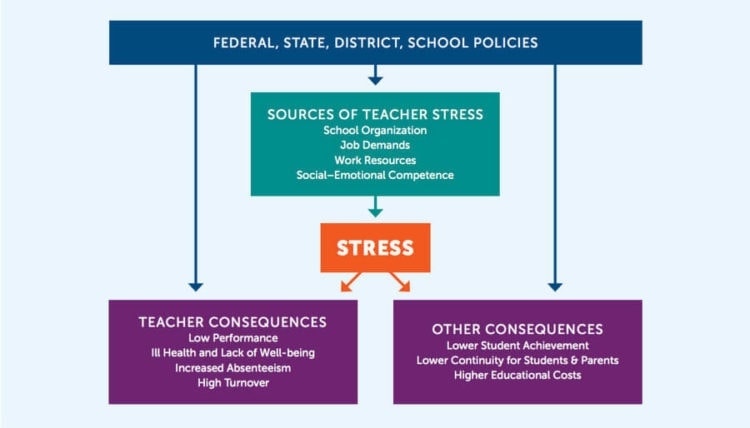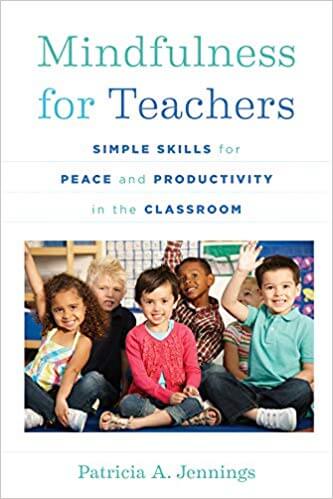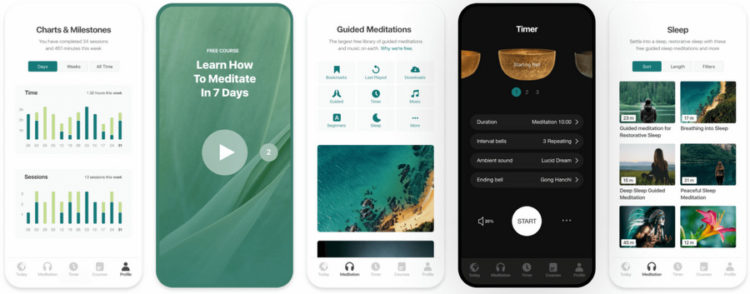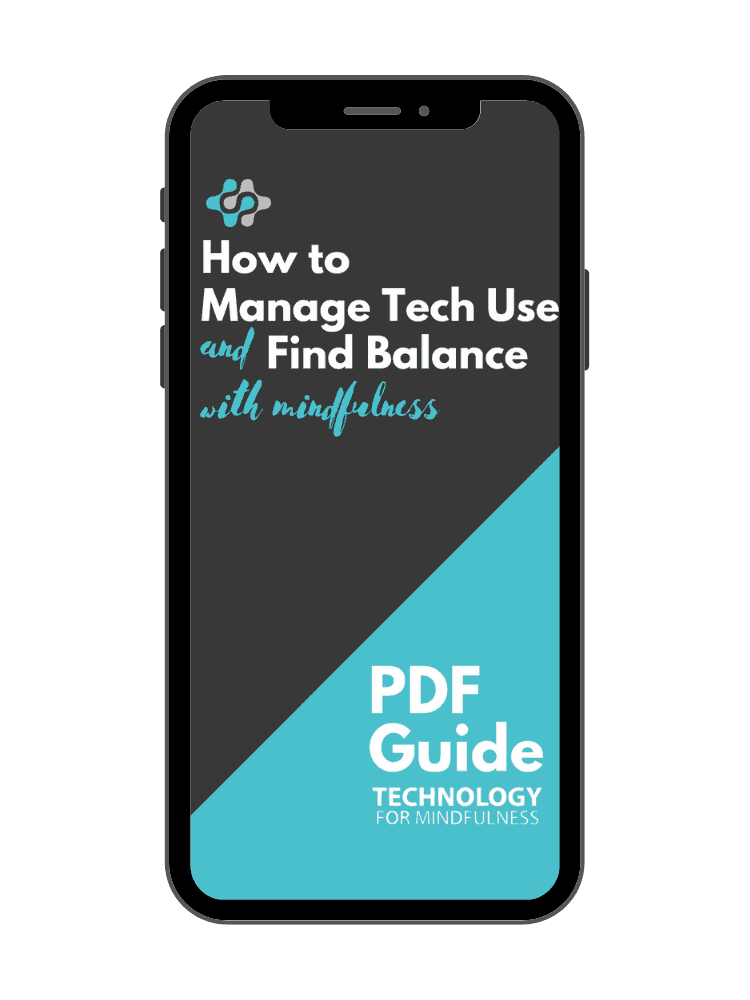As a teacher, there’s a lot that’s out of your control.
Testing requirements. New standards. Budget cuts. Bigger class sizes. Demanding parents.
It’s no wonder teacher stress levels are among the highest of any occupation.
According to a study by the Robert Wood Johnson Foundation, nearly half of the educators surveyed have high daily stress which compromises their health, sleep, quality of life, and teaching performance:

A recent report by Gallup mirrors these results.
In an extensive survey, State of America’s Schools: The Path to Winning Again in Education, nearly 70 percent of teachers report not feeling engaged in their work. Almost half experience job-related stress daily.
But you already knew teaching was a stressful job, didn’t you? The thing is, sometimes it feels like there’s nothing you can do about it. Though, that couldn’t be further from the truth.
5 Mindfulness practices for teachers for stress-management
There’s a lot you can’t control, major changes to the education system being one of them.
But there’s a lot you can control– like your response to daily stress in the classroom.
Here are five great mindfulness practices for teachers, all which you can do within a few short minutes a day.
1. Guided mindfulness meditation
Patricia Jennings, author of Mindfulness for Teachers suggests that:
A daily mindfulness practice can strengthen your awareness muscles so you can be more composed and fully present in your classroom.
However, if you’re intimidated by traditional seated meditation, guided meditations are an excellent alternative. After all, the best meditation is the one you actually do.
The Mindful Teacher offers morning, mid-day, and evening guided meditations specifically designed for teachers. They’re each ten minutes long, so they can be easily incorporated into your daily schedule.
You might also want to check out a mindfulness app like Headspace. They offer a free beginner’s course and thousands of themed meditations. Plus, for those moments when that one student is driving you crazy, they have an SOS feature for a quick mindful break! Best of all, Headspace offers a special rate just for educators – $12.00 per year.
If Headspace isn’t a good fit, check out our list of the top ten mindfulness meditation apps.
2. Mindful walking
One of the best mindfulness practices for teachers is walking.
But we’re not talking about the kind of walk where your mind whirls with thoughts of parent-teacher conferences and next week’s curriculum.
Instead, mindful walking helps you focus your awareness on the present. It’s also useful because directing attention to walking, and even standing, is something you can do throughout the day.
That includes walking to and from the faculty room, between classrooms, and your car to and from the school.
Mindful Schools offers a helpful set of instructions to get you started as well as a mindful walking guided audio. Here’s an excerpt to give you a sense of how it works.
8-Step mindful walking exercise:
- Choose a flat, open path of 10-20 paces.
- Stand still, taking a few moments to feel your body.
- Walk at a comfortable pace, perhaps slightly slower than normal. You want to feel the direct sensations of your feet and legs moving.
- Feel the changing sensations in your feet as you walk: heaviness, pressure, movement, temperature. With each step, feel the steady contact with the ground.
- When you notice your mind engaged in thoughts or stories, allow it to return to the sensations of walking.
- When you reach the end of your walking path, stop and stand still again. Take a few moments to feel the body standing in a neutral state of rest.
- When you’re ready to turn around, include the movements of turning in your awareness. Take another break to stand before beginning to walk in the other direction.
- Try this for a period of 10-15 minutes, increasing the time as you like.
An alternative method, offered by Mindful Teachers, is called the Rainbow Walk. You simply take a walk and look for something red, orange, yellow, green, blue, and purple.
Keep going through the colors, in order, until the end of your walk. This helps your mind focus on the present, taking a break from the usual internal chatter.
3. Breathing exercises
Next, let’s talk about conscious breathing.
If you already pause for a few deep breaths when you’re feeling stressed, you’re on the right track.
Deep abdominal breathing can slow your heartbeat and lower or stabilize blood pressure. This natural physical response will give you a clearer head.
It also gives your brain the time it needs to make a better decision.
As education center Edutopia points out:
When a student disrupts a class by expressing anger or frustration, our instinct is to act immediately before the situation gets worse. Instead, take one or two breaths, using the time to survey the situation and the environment. Those precious seconds could provide critical information.
But practicing mindful breathing doesn’t have to be in the moment of stress. You’ll find that by practicing regularly, it becomes a more natural response in a difficult situation.
The best way to start is with belly breathing. It’s easy to do and very relaxing. You might want to do it at the beginning and end of your day to see how it feels.
6-Step breathing exercise:
- Sit or lie flat in a comfortable position.
- Put one hand on your belly just below your ribs and the other hand on your chest.
- Take a deep breath in through your nose, and let your belly push your hand out. Your chest should not move.
- Breathe out through pursed lips as if you were whistling. Feel the hand on your belly go in, and use it to push all the air out.
- Do this breathing 3 to 10 times. Take your time with each breath.
- Notice how you feel at the end of the exercise.
4. Body scan
Try pairing the belly breathing exercise with a body scan.
It’s common to carry stress in your body. It might be in the form of tense shoulders, clenched jaw, or upset stomach. However, most of us aren’t aware of it.
The body scan is a simple practice that helps you experience how each part of your body feels, without trying to change anything. You slowly move your attention from head to toe, noticing any sensations.
According to the Greater Good Science Center:
The body scan practice may increase our general attunement to our physical needs and sensations, which can, in turn, help us take better care of our bodies and make healthier decisions about eating, sleep, and exercise.
There are plenty of body scan guided meditations online.
Some are designed for a quick check-in like the three-minute meditation provided by UCLA’s Mindfulness Research Center. Others are much longer and focus on each body part for an extended time. These are excellent for listening at bedtime. You may find that you fall asleep before the end of the recording – and that’s okay!
Check out Insight Timer for hundreds of body scan meditations. You’re sure to find a voice and teacher that helps you unwind your body’s tension from a difficult school day.
5. Journaling
Journaling is another one of the best mindfulness practices for teachers because it can help you process emotions and learn from experiences.
You could write about your emotional responses to events that happened throughout the day. Or you might journal about a particular issue that’s been causing a lot of stress.
For example, Patricia Jennings, author of Mindfulness for Teachers, shared this journaling exercise:
6-Step journaling exercise:
- Think about a student you find challenging.
- Recall the last time she or he did something that made teaching difficult.
- What emotions does the memory elicit? Do you feel annoyed? Frustrated?
- How does your body feel? For example, are your shoulders tense? Is your stomach tight?
- Don’t try to stop the feelings or change them. Just sit with them.
- Listen to the thoughts that come from these feelings.
As you can see, journaling can uncover unconscious reactions, helping you notice patterns in your thinking that may or may not be serving you well.
If you find yourself staring at an empty page, try these 25 journal prompts for stress and anxiety.
And remember, if journaling is causing you stress, don’t do it! If it feels like more work, try one of the other four tips instead.
Mindfulness is a tool
These five are some of the best mindfulness practices for teachers. Use them to empower you to better manage stress and tackle the demands of the classroom.
It’s not a stretch to say that your personal wellbeing affects the future of our world.
Take care of yourself, so you can be a mindful role model to your students.



